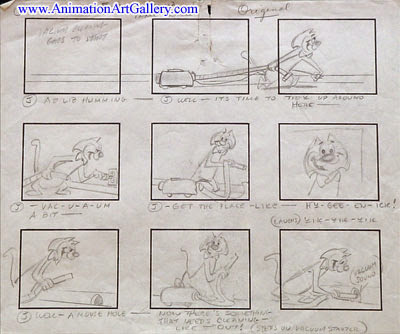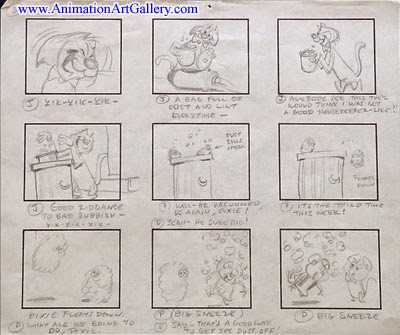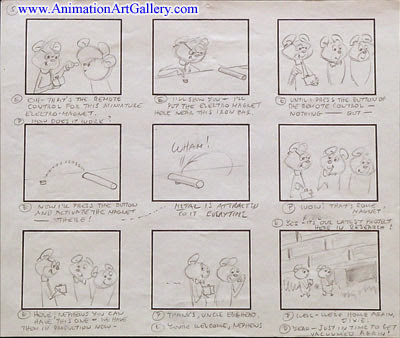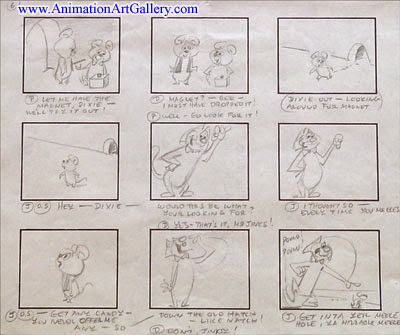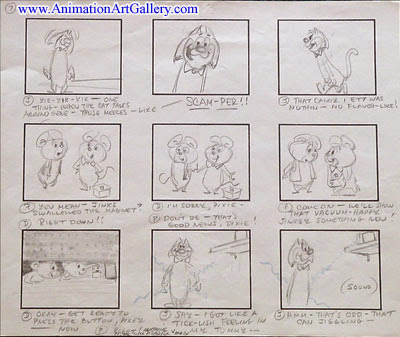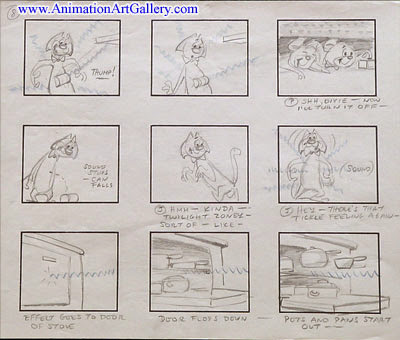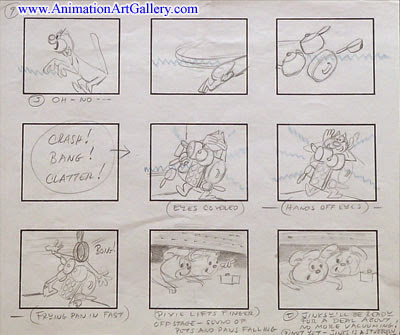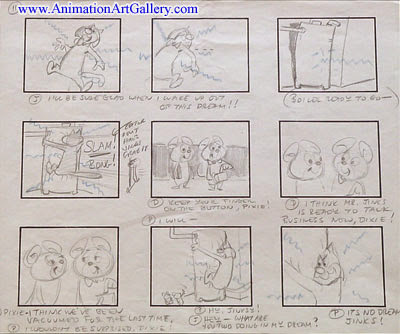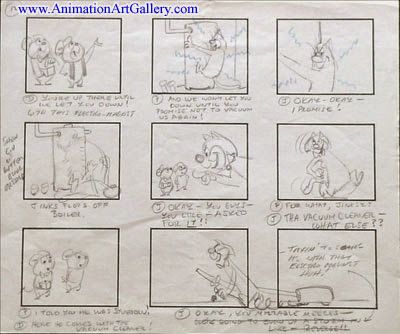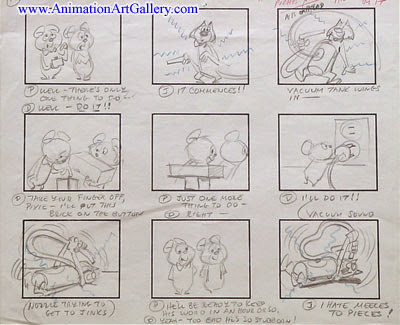“Home Flea” was one of the last Pixie and Dixie cartoons put into production for the 1961-62 season. It underwent a few changes from conception to finished cartoon. For one thing, it was originally titled “Mitey Mite.” But there had already been a Pixie and Dixie cartoon called “Mighty Mite” two seasons earlier, so it would appear a name change was in order. It’s not a very strong (pardon the pun) cartoon and even the play on the term “home free” is pretty weak.
Reader Adel Khan, who’s responsible for finding excellent copies of Pixie and Dixie and Huckleberry Hound cartoons that we’ve used on the blog, pointed out the complete storyboard for “Home Flea” is for sale on eBay, with scans of all the story panels. The story was by Warren Foster, though I don’t think he drew this board. There are instructions to the layout man who, in this cartoon, was Jim Carmichael. Judging by the writing, I believe the first note to Carmichael was added by Joe Barbera.
It’s a shame the scans are, for the most part, pretty small, because it’s tough to impossible to read some of the instructions on the board. For example, on the top of the first sheet is the notation to Carmichael “We have flea model change enuf [?] to give strong man appearance.” And, indeed, the cartoon doesn’t have the rotund, bulbous-nosed flea you see in the story. Compare the frame above to what you see in panel 7, which is the corresponding one in the story.
![]()
![]()
![]()
![]()
Even though they’re only sketches, I like Jinks’ expressions. In the cartoon, John Boersma draws the cat with the eyelids partly closed; some of the story drawings has taken fully open and bigger. And, as per the instructions on the board, the water dish was eliminated for the cartoon.
![]()
![]()
The cartoon follows what you see on the story panels. Daws Butler changes a few words here and there. And the sound effect instruction about the taut wire is what you hear on the audio track.
![]()
Whoever put up these boards on eBay was nice enough to have the last four sets of panels posted individually so we can get a much better look at them. Barbera’s instruction in panel 111 “Cut to eliminate hole” wasn’t followed when the cartoon was shot. I asked Tony Benedict about some of the instructions. His notes:
● Panel 109 probably "one second" refers to a hold after dialogue and before cut.
● Panel 114"six seconds" most likely refers to the length of the dialogue plus action. Timing notes may have been added to the board after recording.
● Panel 116 NS may be referring to North South action achieved by alternating top and bottom pegs for camera jar effect. LS may refer to longer shot. Scratched out note on panel 116 refers to "longer shot."
![]()
![]()
![]()
Here we end the cartoon. The shots from 137 to the end aren’t as tight as indicated in the inset boxes. And Boersma or Carmichael have changed Jinks’ position from what you see in panels 120 and 126.
If you want to try a little exercise in voice acting, play the cartoon in the background and read Mitey Mite’s dialogue from the panels. You’ll quickly notice how Don Messick’s delivery is slow and expressive, far more so than a regular conversation.
My thanks to Adel for finding this storyboard.
Reader Adel Khan, who’s responsible for finding excellent copies of Pixie and Dixie and Huckleberry Hound cartoons that we’ve used on the blog, pointed out the complete storyboard for “Home Flea” is for sale on eBay, with scans of all the story panels. The story was by Warren Foster, though I don’t think he drew this board. There are instructions to the layout man who, in this cartoon, was Jim Carmichael. Judging by the writing, I believe the first note to Carmichael was added by Joe Barbera.
It’s a shame the scans are, for the most part, pretty small, because it’s tough to impossible to read some of the instructions on the board. For example, on the top of the first sheet is the notation to Carmichael “We have flea model change enuf [?] to give strong man appearance.” And, indeed, the cartoon doesn’t have the rotund, bulbous-nosed flea you see in the story. Compare the frame above to what you see in panel 7, which is the corresponding one in the story.




Even though they’re only sketches, I like Jinks’ expressions. In the cartoon, John Boersma draws the cat with the eyelids partly closed; some of the story drawings has taken fully open and bigger. And, as per the instructions on the board, the water dish was eliminated for the cartoon.


The cartoon follows what you see on the story panels. Daws Butler changes a few words here and there. And the sound effect instruction about the taut wire is what you hear on the audio track.

Whoever put up these boards on eBay was nice enough to have the last four sets of panels posted individually so we can get a much better look at them. Barbera’s instruction in panel 111 “Cut to eliminate hole” wasn’t followed when the cartoon was shot. I asked Tony Benedict about some of the instructions. His notes:
● Panel 109 probably "one second" refers to a hold after dialogue and before cut.
● Panel 114"six seconds" most likely refers to the length of the dialogue plus action. Timing notes may have been added to the board after recording.
● Panel 116 NS may be referring to North South action achieved by alternating top and bottom pegs for camera jar effect. LS may refer to longer shot. Scratched out note on panel 116 refers to "longer shot."



Here we end the cartoon. The shots from 137 to the end aren’t as tight as indicated in the inset boxes. And Boersma or Carmichael have changed Jinks’ position from what you see in panels 120 and 126.
If you want to try a little exercise in voice acting, play the cartoon in the background and read Mitey Mite’s dialogue from the panels. You’ll quickly notice how Don Messick’s delivery is slow and expressive, far more so than a regular conversation.
My thanks to Adel for finding this storyboard.


























































































































